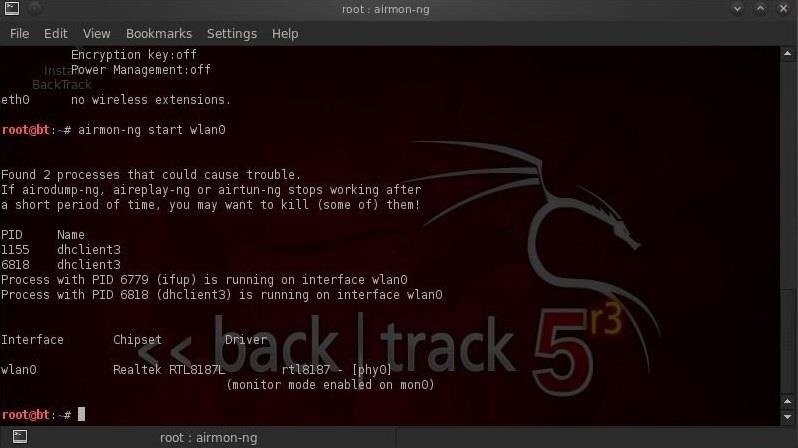When Wi-Fi was first developed in the late 1990s, Wired Equivalent Privacy was created to give wireless communications confidentiality. WEP, as it became known, proved terribly flawed and easily cracked.
As a replacement, most wireless access points now use Wi-Fi Protected Access II with a pre-shared key for wireless security, known as WPA2-PSK. WPA2 uses a stronger encryption algorithm, AES, that's very difficult to crack—but not impossible.
The weakness in the WPA2-PSK system is that the encrypted password is shared in what is known as the 4-way handshake. When a client authenticates to the access point (AP), the client and the AP go through a 4-step process to authenticate the user to the AP. If we can grab the password at that time, we can then attempt to crack it.
In this tutorial, we'll look at using aircrack-ng and a dictionary attack on the encrypted password after grabbing it in the 4-way handshake.
Step 1Put Wi-Fi Adapter in Monitor Mode with Airmon-Ng
Let's start by putting our wireless adapter in monitor mode.
For this to work, we'll need to use a compatible wireless network adapter
- airmon-ng start wlan0
Note that airmon-ng has renamed your wlan0 adapter to mon0.
Step 2Capture Traffic with Airodump-Ng
Now that our wireless adapter is in monitor mode, we have the capability to see all the wireless traffic that passes by in the air. We can grab that traffic by simply using the airodump-ng command.
This command grabs all the traffic that your wireless adapter can see and displays critical information about it, including the BSSID (the MAC address of the AP), power, number of beacon frames, number of data frames, channel, speed, encryption (if any), and finally, the ESSID (what most of us refer to as the SSID). Let's do this by typing:
- airodump-ng mon0
Note all of the visible APs are listed in the upper part of the screen and the clients are listed in the lower part of the screen.
Step 3Focus Airodump-Ng on One AP on One Channel
Our next step is to focus our efforts on one AP, on one channel, and capture critical data from it. We need the BSSID and channel to do this. Let's open another terminal and type:
- airodump-ng --bssid 08:86:30:74:22:76 -c 6 --write WPAcrack mon0
- 08:86:30:74:22:76 is the BSSID of the AP
- -c 6 is the channel the AP is operating on
- WPAcrack is the file you want to write to
- mon0 is the monitoring wireless adapter*
As you can see in the screenshot above, we're now focusing on capturing data from one AP with a ESSID of Belkin276 on channel 6. The Belkin276 is probably a default SSID, which are prime targets for wireless hacking as the users that leave the default ESSID usually don't spend much effort securing their AP.
Step 4Aireplay-Ng Deauth
In order to capture the encrypted password, we need to have the client authenticate against the AP. If they're already authenticated, we can de-authenticate them (kick them off) and their system will automatically re-authenticate, whereby we can grab their encrypted password in the process. Let's open another terminal and type:
- aireplay-ng --deauth 100 -a 08:86:30:74:22:76 mon0
- 100 is the number of de-authenticate frames you want to send
- 08:86:30:74:22:76 is the BSSID of the AP
- mon0 is the monitoring wireless adapter
Step 5Capture the Handshake
In the previous step, we bounced the user off their own AP, and now when they re-authenticate, airodump-ng will attempt to grab their password in the new 4-way handshake. Let's go back to our airodump-ng terminal and check to see whether or not we've been successful.
Notice in the top line to the far right, airodump-ng says "WPA handshake." This is the way it tells us we were successful in grabbing the encrypted password! That is the first step to success!
Step 6Let's Aircrack-Ng That Password!
Now that we have the encrypted password in our file WPAcrack, we can run that file against aircrack-ng using a password file of our choice. Remember that this type of attack is only as good as your password file. I'll be using the default password list included with aircrack-ng on BackTrack named darkcOde.
We'll now attempt to crack the password by opening another terminal and typing:
- aircrack-ng WPAcrack-01.cap -w /pentest/passwords/wordlists/darkc0de
- WPAcrack-01.cap is the name of the file we wrote to in the airodump-ng command
- /pentest/passwords/wordlist/darkc0de is the absolute path to your password file







Comments
Post a Comment